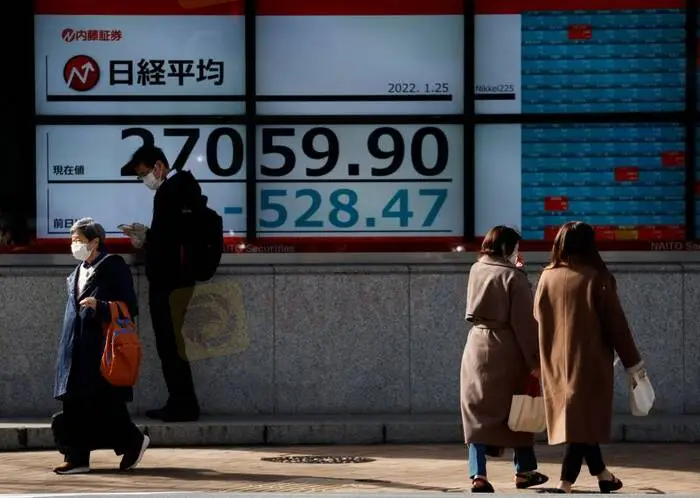简体中文
繁體中文
English
Pусский
日本語
ภาษาไทย
Tiếng Việt
Bahasa Indonesia
Español
हिन्दी
Filippiiniläinen
Français
Deutsch
Português
Türkçe
한국어
العربية
Equities tumble and U.S. dollar rises as Russia/ Ukraine fears escalate
Abstract:Asian stocks steadied on Wednesday and demand for safe-havens waned a little as investors regarded Russian troop movements near Ukraine and initial Western sanctions as leaving room to avoid a war, while a rate hike lifted New Zealands dollar.

Investors around the world lost their appetite for risk on Wednesday, with stocks selling off and the U.S. dollar gaining some ground as Ukraine declared a state of emergency amid intensifying fears of a full-scale Russian invasion.
Trading in many asset classes has been volatile since Russian President Vladimir Putins dispatch of troops earlier this week into parts of Ukraine. This triggered sanctions from Western countries and threats of more if Moscow advances further.
Oil futures, which were whipsawed during the day, settled well below their session highs and U.S. Treasury yields, while staying above Tuesdays close, were also volatile.
Ukraine declared a state of emergency and told its citizens to flee Russia, while Moscow began evacuating its Kyiv embassy. The Russian-backed separatist leader of a Ukrainian breakaway region said Ukrainian government forces should withdraw from territory that his self-proclaimed state has claimed and take their weapons with them.
A senior U.S. official said on Wednesday that Russia is as ready as it can be to launch what could be a full-scale invasion, with 80 percent of troops assembled around Ukraine in attack positions.
After rising as much as 0.7% earlier on Wednesday the MSCI World Index, a leading gauge of equity markets globally, reversed course in morning trading and deepened losses as the day wore on to finish off 1.2%, registering its lowest level since April 2021. After falling as much as 1% and rising almost 2% during the day, Brent crude settled unchanged from Tuesdays close at $96.84, while West Texas Intermediate settled up 0.21% at $92.10 per barrel after earlier falling as much as 1.9% and rising 1.7% all in the same day. [O/R]
Investors have also been grappling with the prospects of a U.S. Federal Reserve policy tightening aimed at combating surging inflation. But these worries have “been somewhat superseded by events in eastern Europe and in Russia,” said Rhys Williams, chief strategist at Spouting Rock Asset Management.
“So in the very short term, markets will go up or down based on whether (Putin) marches to Kyiv,” said Williams, adding that investors had appeared to accept Russias move into the Donetsk and Luhansk regions in Ukraine.
But if Putin “goes to Kyiv and there is a regime change and potentially a guerrilla war for the next two generations, thats a more difficult scenario and there is frankly only one person who can decide this.”
The Dow Jones Industrial Average fell 464.85 points, or 1.38%, to 33,131.76, barely above the 33,119.685 level that would have confirmed a correction.
The S&P 500 lost 79.26 points, or 1.84%, to end at 4,225.5 and the Nasdaq Composite dropped 344.03 points, or 2.57%, to 13,037.49.
Michael James, managing director of equity trading at Wedbush Securities in Los Angeles, said there was currently “very little positive validation for buying anything.”
“If anything, President Putin is digging his heels in despite the increased sanctions,” said James. “Thats really adding to elevated nervousness about further aggressive actions and what that will mean for commodities and inflation overall as well as potentially lower market prices as overall equity sentiment continues to worsen.”
Treasury yields were higher as investors monitored Russia-Ukraine events and remained concerned about inflation and a potential Federal Reserve policy mistake.
Benchmark 10-year notes last fell 13/32 in price to yield 1.9912%, up from 1.948% late on Tuesday. The 30-year bond last fell 30/32 in price to yield 2.2963% up from 2.253% while the 2-year note last fell 1/32 in price to yield 1.6016%, up from 1.587%.
Trading was also choppy in currencies with the dollar index last up 0.127% and the euro down 0.18% at $1.1305.
The U.S. dollar strengthened sharply and was last up 3.2% against the Russian rouble, more than reversing its losses on Tuesday against the Russian currency.
The New Zealand dollar NZD= jumped after the Reserve Bank of New Zealand raised interest rates and said more tightening could be necessary. The kiwi last was up 0.71% versus the greenback at $0.678.
Palladium rose 4.5% to a near six-month peak driven by fears of a hit to supply from top producer Russia. Gold added 0.6% to trade at $1,908.62 an ounce.
Russia is the world‘s third-largest producer of gold, while the country’s Nornickel is also a major producer of palladium and platinum, both of which are used in catalytic converters to clean car exhaust fumes.

Disclaimer:
The views in this article only represent the author's personal views, and do not constitute investment advice on this platform. This platform does not guarantee the accuracy, completeness and timeliness of the information in the article, and will not be liable for any loss caused by the use of or reliance on the information in the article.
Read more

Blockchain Decentralization: Empowering a Trustless Future
In recent years, blockchain technology has rapidly evolved from a niche innovation behind Bitcoin into a transformative force across industries. At its core, blockchain decentralization refers to the distribution of authority and decision-making away from a central entity and into the hands of a distributed network of participants. This shift redefines how data is stored and verified and paves the way for trustless, transparent, and resilient systems that challenge traditional centralized models.

The president of @Liberland, @Vít Jedlička come on stage, dialogue on trading security.
The 2025 WikiEXPO Hong Kong Station is about to grandly open. the president of @Liberland, @Vít Jedlička come on stage, dialogue on trading security.

Countdown: 1 day.WikiEXPO2025's first stop, Hong Kong, is about to open.
⏰ Countdown: 1 day. WikiEXPO2025's first stop, Hong Kong, is just tomorrow. Focus on transaction security and explore new investment opportunities. ???? Get ready to start now. See you tomorrow.

JustForex vs JustMarkets: A Comprehensive Comparison in 2025
Selecting the right forex broker can make the difference between trading success and frustration for most investors, especially retail investors. As retail traders gain unprecedented access to global markets, the choice between platforms like JustForex and JustMarkets becomes increasingly significant. Both brokers offer some shining features within the forex and CFD trading space, but their approaches differ in some areas.
WikiFX Broker
Latest News
TradingView Brings Live Market Charts to Telegram Users with New Mini App
Trump tariffs: How will India navigate a world on the brink of a trade war?
Interactive Brokers Launches Forecast Contracts in Canada for Market Predictions
Authorities Alert: MAS Impersonation Scam Hits Singapore
Stocks fall again as Trump tariff jitters continue
INFINOX Partners with Acelerador Racing for Porsche Cup Brazil 2025
Regulatory Failures Lead to $150,000 Fine for Thurston Springer
April Forex Trends: EUR/USD, GBP/USD, USD/JPY, AUD/USD, USD/CAD Insights
March Oil Production Declines: How Is the Market Reacting?
Georgia Man Charged in Danbury Kidnapping and Crypto Extortion Plot
Currency Calculator







